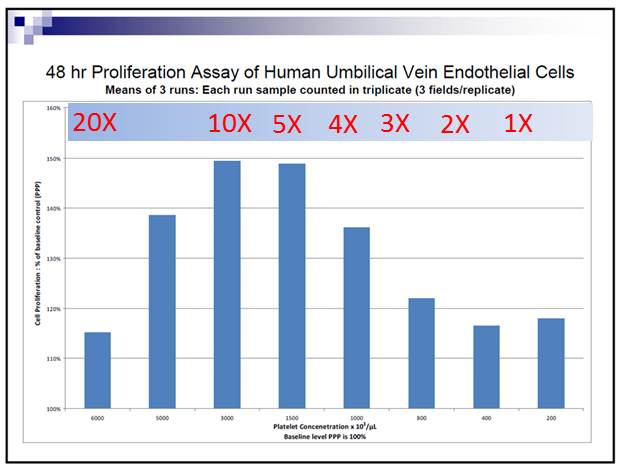Platelet Rich Plasma-Can you get a Better Result through Higher Platelet Concentration?
I’ve blogged before on the problems with bedside machine made PRP-namely too much blood contamination. Another issue is platelet concentration. Some PRP machine makers tout their ability to get platelet concentrations as high as 11X over baseline, while others say that too many platelets that can cause cells to be inhibited. Since the goal of all PRP is to stimulate the damaged area’s natural cells toward repair, inhibited cells could be a bad thing. I have placed a graph by Kevy et al below and added a bar on top so you can easily see the platelet concentration over baseline (assumes a normal platelet count is 300 exp 3/microliter). Note that as the platelet concentration gets to about 5X (about 5 times as many platelets per volume as the average person has in their blood), the proliferation effect on these cells maxes out (the height of the bar is about at it’s highest). So based on this data put out by Harvest (a machine maker), it would seem that it’s just not worth concentrating platelets beyond 5X (which is curiously right about where their machine concentrates). When I first saw this slide in a lecture, I was confused, as the cell type they were trying to stimulate was “Human Umbilical Vein Endothelial Cells”. Huh? When PRP is used to treat orthopedic injuries, we never try to get cells lining the blood vessels of a baby’s umbilical cord to grow! As a result, I concluded that this experiment had little “generalizability” to how most physicians use PRP. In addition, knowing that the Harvest machine (like many others) has a serious blood contamination problem and knowing how excessive blood in mesenchymal stem cell culture can cause problems for the stem cells, I wondered what would happen if we ran the right experiment rather than the wrong one.
The first change needed for the “right” experiment was to replace the baby vein cells with adult mesenchymal stem cells (the type most responsible for orthopedic tissue repair and already located in all of these tissues). The second modification was to get rid of the bloody machine made PRP and use our SCP procedure (which has no blood contamination, since it’s custom made for each patient rather than mass manufactured in a machine). Finally, we needed to see how the stem cells responded when stimulated by platelets from different age groups, as the amount of growth factors in platelets declines with age. The graph below is the result of that “right” experiment rerun by our advanced Colorado lab. Note that for all patient groups (patients in their 30’s, 40’s, and 50’s), a higher concentration of bloodless platelet rich plasma stimulates more orthopedic stem cell growth. This is all the way up to 20X! In addition, look at the differences in the amount of stimulation between 5, 10, 15, and 20X for the “50’s” patients. Concentrating in this age group makes a huge difference. Why? I suspect we’re seeing what we have seen before in other data sets that we’ve run-that there’s a saturation point. This means that when you’re young, you have a lot of growth factors in your platelets, so at some point concentrating them too much gets beyond a limit where your cells just cant respond anymore. As an example, if you add a little sugar to your drink, it’s a little sweet. However, you can also get to a point where adding more sugar on top of a lot of sugar isn’t going to make the drink much sweeter. In addition, remember that for growth factors there are two parts of the equation. On the one side you have the amount of growth factors coming from platelets, while on the other there are receptors that these growth factors stimulate on the damaged tissue or local stem cells. The body frequently adjusts the number of receptors on cells up or down based on what’s available to trigger those receptors. Having less growth factors circulating around them, older stem cells may express more receptors for these platelet growth factors on their surfaces. Having more receptors means they can respond better to less stimulus coming from older and growth factor depleted platelets. Flooding those older cells with lots of platelet growth factors may therefore give an even better proliferation response, as there are more receptors for the GFs to stimulate. Keeping with our sugary drink analogy, many people who eat very little sugar find that eating food that is usually sweetened is “too sweet”. The reason is the same, if you eat less sugar, your body builds more sugar receptors, so what most people would think of as “normal” you think is “too sweet”. The upshot? Concentrating bloodless and custom made PRP to high levels in older patients is likely well worth the effort. While the best bedside machines producing mass manufactured PRP can only get to about 11X over baseline, we can concentrate platelets in our lab to 20X (as can any of our network sites). So if you’re middle aged, you may want to take advantage of this additional concentration to maximally stimulate your stem cells for repair!

If you have questions or comments about this blog post, please email us at [email protected]
NOTE: This blog post provides general information to help the reader better understand regenerative medicine, musculoskeletal health, and related subjects. All content provided in this blog, website, or any linked materials, including text, graphics, images, patient profiles, outcomes, and information, are not intended and should not be considered or used as a substitute for medical advice, diagnosis, or treatment. Please always consult with a professional and certified healthcare provider to discuss if a treatment is right for you.


